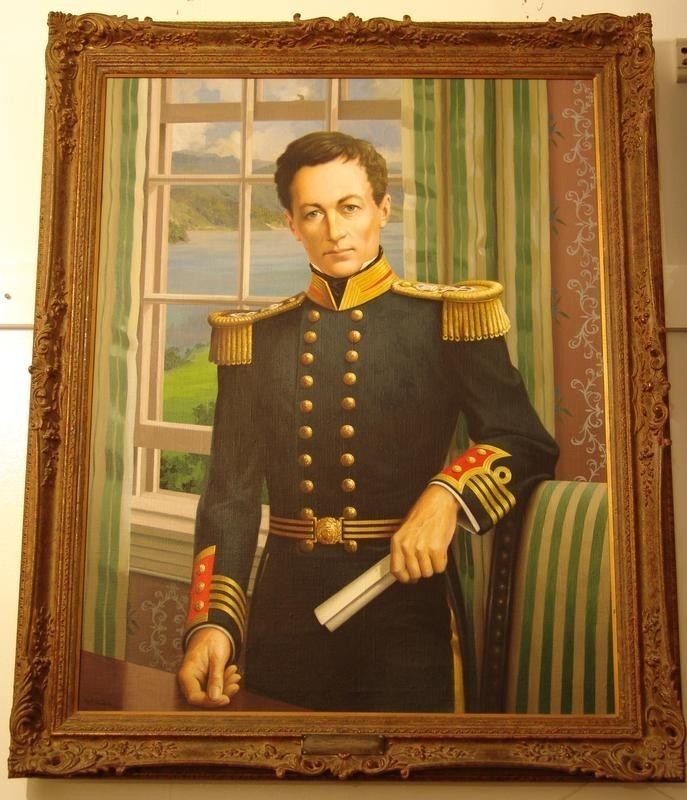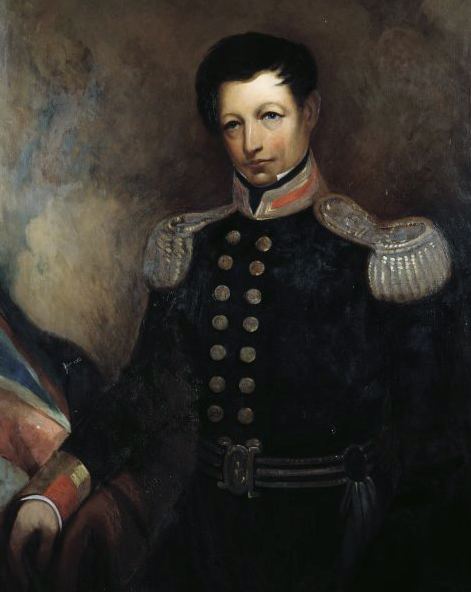Preceded by Office established Succeeded by Office abolished Name William Hobson | Resigned September 10, 1842 Preceded by Office established | |
 | ||
Died September 10, 1842, Auckland, New Zealand | ||
William hobson
Captain William Hobson RN (26 September 1792 – 10 September 1842) was the first Governor of New Zealand.
Contents
- William hobson
- William Hobsons vision
- Early life
- Career in Australia
- Career in New Zealand
- Lieutenant Governor of New Zealand
- Treaty of Waitangi
- Governor of New Zealand
- References

Hobson was dispatched from London in August 1839 with instructions to take the constitutional steps needed to establish a British colony in New Zealand; he was instructed to negotiate a voluntary transfer of sovereignty from Māori to the British Crown. He was sworn in as Lieutenant-Governor in Sydney and arrived in New Zealand on 29 January 1840. Hobson was one of the co-authors of the Treaty of Waitangi. In May 1840, Hobson proclaimed sovereignty over the whole country, and New Zealand was constituted as a colony on November 16, 1840.

Promoted to the position of Governor on 3 May 1841, Hobson died 16 months later from a longterm illness.

William Hobson's vision
Early life

William Hobson was born in Waterford, Ireland, the son of Samuel Hobson, a barrister. Some sources put his year of birth in 1793.
He joined the Royal Navy on 25 August 1803 as a second-class volunteer. He served in the Napoleonic wars and was later involved in the suppression of piracy in the Caribbean. He became a midshipman in 1806 and some seven years later was a first lieutenant. He was promoted to commander in May 1824 and commanded HMS Scylla between 1826 and 1828. In December 1834, he obtained a commission from Lord Auckland to the East Indies on HMS Rattlesnake.
Career in Australia
In 1836, he was ordered to Australia, arriving at Hobart on 5 August 1836 and at Sydney 18 days later. On 18 September 1836, HMS Rattlesnake left for Port Phillip District (later Melbourne) conveying Captain Lonsdale and other officials to the new colony. During the next three months, Hobson and his officers thoroughly surveyed Port Phillip, the northern portion of which, by direction of Governor Sir Richard Bourke, was named Hobson's Bay, after him. His ship was involved in the founding of Williamstown. He was offered the position of Superintendent of the Bombay Marine at a salary of £2000 a year, but he had taken a liking to Australia and was a candidate for the governorship of Port Phillip, although the salary was not expected to be more than £800 a year.
Career in New Zealand
On 26 May 1837 Hobson sailed to the Bay of Islands, New Zealand, in response to a request for help from James Busby, the British Resident, who felt threatened by wars between Māori iwi (tribes). For three months in 1837 Pōmare II (Whiria) fought with Titore until a peace agreement was negotiated by Tareha. On his return to England in 1838, Hobson submitted a report on New Zealand, in which he proposed establishing British sovereignty over the islands in small pockets similar to the Hudson's Bay Company in Canada.
Lieutenant-Governor of New Zealand
At the time, the British government recognised the sovereignty of the Māori people, as represented in the Declaration of the Independence of New Zealand of October 1835, which Busby had organised. Hobson was appointed Lieutenant Governor under the Governor of New South Wales, Sir George Gipps (ratified on 30 July 1839) and British consul to New Zealand (confirmed on 13 August 1839). On 14 August 1839 Lord Normanby issued him with detailed instructions, giving reasons for intervention in New Zealand and directions for the purchase of land "by fair and equal contracts". (The land was later resold to settlers at a profit to provide for further operations.)
Hobson arrived in the Bay of Islands aboard the HMS Herald on 29 January 1840 (which northern New Zealanders mark as Auckland Anniversary Day) with a small group of officials, including an Executive Council consisting of Colonial Secretary Willoughby Shortland, Colonial Treasurer George Cooper and Attorney-General Francis Fisher. The Legislative Council comprised the above officials and three Justices of the Peace. Hobson appointed as three Magistrates, Messrs. Shortland, Johnson, and Matthew.
Treaty of Waitangi
Upon arrival, Hobson almost immediately drafted the Treaty of Waitangi together with his secretary James Freeman and Busby. After obtaining signatures to the Treaty at the Bay of Islands (6 February 1840), he travelled to Waitemata Harbour to obtain more signatures and to survey a suitable location for a new capital (he also sent the Deputy Surveyor-General, William Cornwallis Symonds, to other areas to obtain more signatures). After suffering a stroke on 1 March 1840, he was taken back to the Bay of Islands, where he recovered sufficiently to continue work.
On 21 May 1840, in response to the creation of a "republic" by the New Zealand Company settlers of Port Nicholson (later Wellington), who were laying out a new town under the flag of an independent New Zealand, Hobson asserted British sovereignty over the whole of New Zealand, despite the incompleteness of the treaty signing. He sent Willoughby Shortland and some soldiers to Port Nicholson on 25 May 1840, and the council of the settlers was disbanded. Their leader, William Wakefield, later travelled to the Bay of Islands to pledge allegiance to the Crown. His suggestion to make Port Nicholson the capital was rejected in favour of Hobson's plan for a new town on Waitemata Harbour, to be named Auckland after the Earl of Auckland.
On 11 July 1840 the French frigate L'Aube arrived at the Bay of Islands on its way to Banks Peninsula as part of the settlement plan of the Nanto-Bordelaise Company. Hobson immediately sent two magistrates to the area to establish the British claim to sovereignty by holding courts.
Near the end of 1840, the Port Nicholson settlers sent a petition to Queen Victoria calling for Hobson's dismissal over his treatment of them. Hobson responded on 26 May 1841 to the Foreign Secretary.
Governor of New Zealand
In November 1840, the Queen signed a royal charter for New Zealand to become a Crown colony separate from New South Wales. Hobson was sworn in as Governor and Commander in Chief on 3 May 1841.
Hobson travelled to Wellington in August 1841, where he heard the complaints of settlers and selected magistrates. He then visited Akaroa to settle the French claims. Back in Auckland, he had some difficulty with the Māori, and his government was ridiculed by journalists in Wellington and Auckland. He responded by closing down the New Zealand Herald and Auckland Gazette. With his government low on funds, he resorted to issuing unauthorised bills on the British Treasury in 1842. Hobson faced opposition from the "Senate clique" radicals who sent a petition to the Foreign Secretary to have Hobson recalled. One of Hobson's last actions was to declare an Auckland Anniversary Day, to mark the anniversary of his arrival in the Bay of Islands.
Hobson suffered a second stroke and died on 10 September 1842, prior to being recalled from office. He was buried in the Symonds Street cemetery in Auckland. The Waitakere suburb of Hobsonville is named after him.
